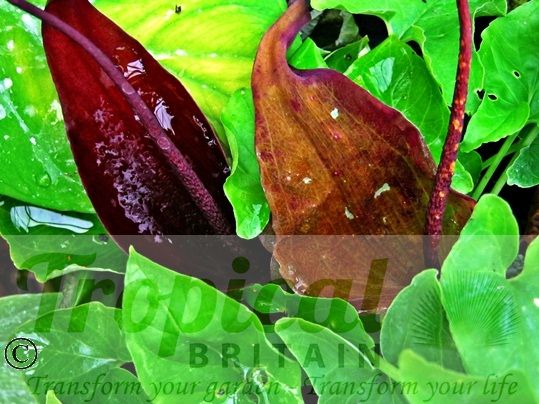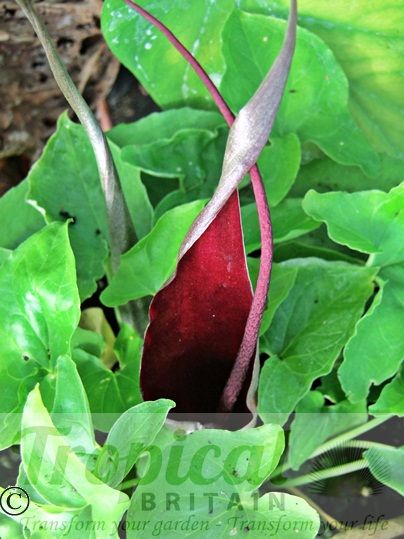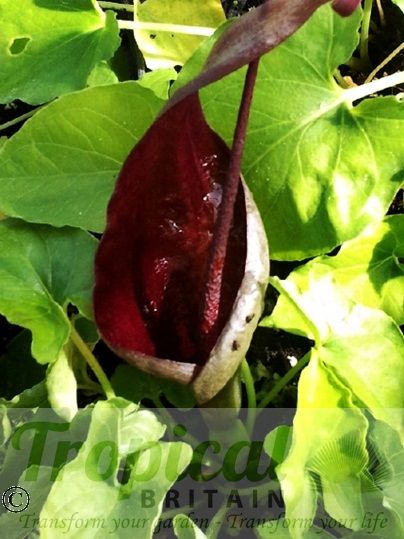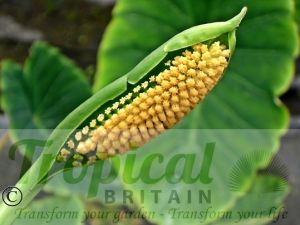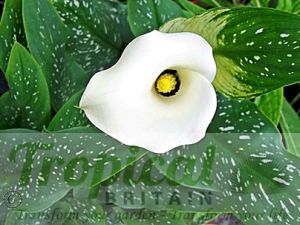Typhonium roxburghii is a small-growing aroid from Asia with diminutive triangular-shaped glossy green leaves with extraordinary velvety inflorescences borne throughout the summer. It has elongated spathes, rich purple in colour but more reddish as the sun reaches them, usually twisted at the end with a long thin spadix appendix that extends beyond the spathe giving the appearance of a miniature Amorphophallus or Dracunculus. Like those species, it gives off a charmingly malodorous scent that is best likened to a bad case of halitosis.
Typhonium roxburghii - although diminutive in size - grows quickly and slowly spreads to create a small clump. They like a moist but well-drained humus-rich growing medium and a warm sheltered semi-shaded aspect. Because of their small size they are often best grown in pots. These can be brought into a frost-free environment during the winter dormant period or the small tubers can be stored dry over winter. As the plants get larger and you become accoustomed to their cycle you can experiment with growing part of the clump outdoors in a sheltered spot similar to the woodland type of environment favoured by the earlier-flowering Arisaemas or Pinellias. Reasonably cold tolerant they can be overwintered outside provided the substrate is very well-drained and an extra layer of protective mulch is added in late autumn.
A very easy plant to grow it is always a talking point as your garden guests try to find the source of the strangely compelling yet simultaneously repugnant aroma.
Additional Information
| Order | Alismatales |
|---|---|
| Family | Araceae |
| Sub-Family | Aroideae |
| Synonyms | Arum diversifolium, Arum roxburghii, Arum trilobatum, Dracunculus divaricatus, Typhonium amboinense, Typhonium blumei, Typhonium divaricatum, Typhonium divaricatum var. mottleyanum, Typhonium divaricatum var. robustum, Typhonium divaricatum var. roxburghii, Typhonium divaricatum var. schottii, Typhonium javanicum, Typhonium mottleyanum, Typhonium schottii |
| Geographical Origin | Asia and SE Asia |
| Cultivation | Warm semi-shade to some sun. Sheltered aspect. Well-drained but moist humus-rich soil. |
| Eventual Height | 15cm |
| Eventual Spread | 15-30cm |
| Hardiness | More hardy than most people realise they can take temperatures as low as -15C provided they have a very well-drained substrate and a thick layer of mulch. Often grown in pots that are overwintered indoors or the tubers stored frost-free and dry |

Free DELIVERY
ON ALL ORDERS OVER £99THIS OFFER IS VALID ON ALL OUR STORE ITEMS.

